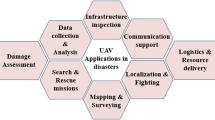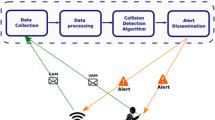Abstract
In this article, we utilize the idea of multipoint relays (MPRs) found in literature (Jacquet et al. in Proceedings of IEEE INMIC, 2001), to propagate accident information in a restricted way (e.g., only backwards). We devise an algorithm to identify MPRs that are geographically situated behind a particular node using only its neighbor table, and speed information of the neighboring vehicles. With the identification of the backward MPRs, it is possible to restrict the information dissemination to vehicles behind a particular vehicular ad-hoc network (VANET) node only. This might benefit the approaching vehicles so that the driver could take preventive measures in real-time since he/she will have an indication of the severity of road conditions ahead. We assume that there exists an inter vehicular network using optimized link state routing (OLSR) where accident information can be propagated to all nodes using on-going OLSR control packets. We envision our application will run on top of existing routing protocols (e.g., OLSR), thereby resulting in very little integration effort, and retaining OLSR’s reduced network traffic advantage through the use of MPRs. We analyze our back MPR identification algorithm in a detailed manner. We also show that by using our approach the location of the accident alert instigator node could be pinpointed if a subset of the nodes in the same VANET know their geographical positions. We use VANET mobility models generated by SUMO into NS-3 for our simulations, and also perform preliminary experiments to verify the algorithm’s effectiveness. Our analysis and experiments show favorable results.
















Similar content being viewed by others
References
Hossain, A. K. M. M., Mekbungwan, P., & Kanchanasut, K. (2011). Directed information dissemination in VANET. In AINTEC’11, Bangkok, Thailand.
Jacquet, P., Mühlethaler, P., Clausen, T., Laouiti, A., Qayyum, A., & Viennot, L. (2001). Optimized link state routing protocol for ad hoc networks. In Proceedings of IEEE INMIC.
Mohammad, S., Rasheed, A., & Qayyum, A. (2011). VANET architectures and protocol stacks: A survey. In Communication technologies for vehicles, volume 6596 of lecture notes in computer science (pp. 95–105). Berlin, Heidelberg: Springer.
Li, F., & Wang, Y. (2008). Routing in vehicular ad hoc networks: A survey. IEEE Vehicular Technology Magazine, 2(2), 12–22.
Luís, M., Oliveira, R., Bernardo, L., & Pinto, P. (2010). Improving routing performance in high mobility and high density ad hoc vehicular networks. In Proceedings of the 33rd IEEE conference on Sarnoff (pp. 121–126). NJ, USA.
Toutouh, J., Garcia-Nieto, J., & Alba, E. (2010). Optimal configuration of OLSR routing protocol for VANETs by means of differential evolution. In Proceedings of the International Conference on Metaheuristics and Nature Inspired Computing (META’10), Tunisia.
Ermel, E., & Mühlethaler, P. (2007). Using OLSR multipoint relays (MPRs) to estimate node positions in a wireless mesh network. In Proceedings of the European Wireless.
Minenoa, H., Sogab, K., Takenakad, T., Terashimac, Y., & Mizunod, T. (2011). Integrated protocol for optimized link state routing and localization: OLSR-L. Simulation Modelling Practice and Theory 19(8), 1711–1722.
Clark, B. N., Colbourn, C. J., & Johnson, D. S. (1991). Unit disk graphs. Discrete Math, 86(1-3), 165–177.
Nzouonta, J., & Borcea, C. (2006). STEID: A protocol for emergency information dissemination in vehicular networks. Tech. rep., Department of Computer Science, New Jersey Institute of Technology.
J. Blum, A. E., & Hoffmman, L. (2004). Challenges of intervehicle ad hoc networks. IEEE Trans. Intelligent Transportation Systems 5(4), 347–351.
Ziliaskopoulos, A., & Zhang, J. (2003). A zero public infrastructure vehicle based traffic information system. In Proceedings of TRB.
Wischoff, L., Ebner, A., Rohling, H., Lott, M., & Halfmann, R. (2003). SOTIS-a self-organizing traffic information system. In Proceedings of IEEE VTC-Spring.
Hartenstein, H., Bochow, B., Ebner, A., Lott, M., Radimirsch, M., & Vollmer, D. (2001). Position-aware ad hoc wireless networks for inter-vehicle communications: The fleetnet project. In Proceedings of ACM MobiHoc.
Goel, S., Senouci, S., & Ozbay, K. (2004). Ascertaining viability of wi-fi based vehicle-to-vehicle network for traffic information dissemination. In Proceedings of IEEE ITS.
Zeng, Y., Xiang, K., Li, D., & Vasilakos, A. V. (2012). Directional routing and scheduling for green vehicular delay tolerant networks. Wireless Networks. http://dx.doi.org/10.1007/s11276-012-0457-9.
Zhang, Z., Mao, G., & Anderson, B. (2011). On the information propagation process in mobile vehicular ad hoc networks. Vehicular Technology, IEEE Transactions on, 60(5), 2314–2325.
Ma, X., Zhang, J., Yin, X., & Trivedi, K. (2012). Design and analysis of a robust broadcast scheme for VANET safety-related services. Vehicular Technology, IEEE Transactions on, 61, 46–61.
Jerbi, M., Jannotti, J., Rasheed, T., & Ghamri-Doudane, Y. (2007). An infrastructure-free traffic information system for vehicular networks. In Proceedings of IEEE VTC-Fall.
Ghafoor, K. Z., Abu Bakar, K., Lloret, J., Khokhar, R. H., & Lee, K. C. (2012). Intelligent beaconless geographical forwarding for urban vehicular environments. Wireless Networks. http://dx.doi.org/10.1007/s11276-012-0470-z.
Lo, N. W., & Tsai, H. C. (2009). A reputation system for traffic safety event on vehicular ad hoc networks. EURASIP Journal on Wireless Communications and Networking 2009:9:1–9:2.
Viennot, L. (1998). Complexity results on election of multipoint relays in wireless networks. Tech. rep., INRIA.
Qayyum, A., Viennot, L., & Laouiti, A. (2000). Multipoint relaying: An efficient technique for flooding in mobile wireless networks. Tech. Rep. RR-3898, INRIA.
Cormen, T. H., Leiserson, C. E., Rivest, R. L., & Stein, C. (2009). Introduction to algorithms (3rd ed.). Cambridge, MA: The MIT Press.
Simulation of Urban MObility (SUMO): Open source, highly portable, microscopic road traffic simulation package. http://sumo.sourceforge.net.
The ns-3 network simulator: A discrete-event network simulator. http://www.nsnam.org.
Olsrd: An adhoc wireless mesh routing daemon. http://www.olsr.org.
Acknowledgments
This work has been supported by Intelligent Transportation System Cluster of the National Science and Technology Development Agency (NSTDA), Thailand and the THNIC Foundation.
Author information
Authors and Affiliations
Corresponding author
Additional information
This work was done while A. K. M. Mahtab Hossain was working at intERLab, Asian Institute of Technology, Thailand.
This article is an extended version of [1].
Rights and permissions
About this article
Cite this article
Hossain, A.K.M.M., Mekbungwan, P. & Kanchanasut, K. Directed information dissemination in vehicular ad-hoc networks. Wireless Netw 20, 899–916 (2014). https://doi.org/10.1007/s11276-013-0655-0
Published:
Issue Date:
DOI: https://doi.org/10.1007/s11276-013-0655-0




